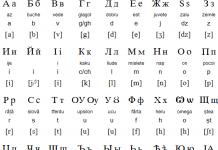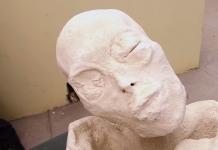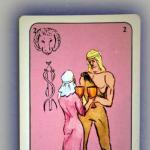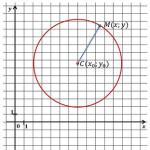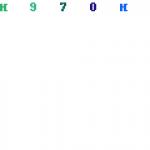Class 7G, Z
Lesson topic: “The relative position of two circles”
Goal: to know possible cases of mutual arrangement of two circles; apply knowledge when solving problems.
Objectives: Educational: to facilitate the creation and consolidation in students of a visual representation of possible cases of the arrangement of two circles; students will be able to:
Establish a connection between the relative positions of circles, their radii and the distance between their centers;
Analyze a geometric design and mentally modify it,
Develop planimetric imagination.
Students will be able to apply theoretical knowledge to problem solving.
Lesson type: lesson introducing and consolidating new knowledge of the material.
Equipment: presentation for the lesson; compass, ruler, pencil and textbook for each student.
Tutorial: . “Geometry 7th grade”, Almaty “Atamura” 2012
During the classes.
Organizing time. Checking homework.
3. Updating of basic knowledge.
Repeat the definitions of circle, circle, radius, diameter, chord, distance from a point to a straight line.
1) 1) What cases of the location of a line and a circle do you know?
2) Which line is called tangent?
3) Which line is called a secant?
4) Theorem about diameter perpendicular to chord?
5) How is the tangent in relation to the radius of the circle?
6) Fill out the table (on cards).
- Students, under the guidance of the teacher, solve and analyze problems.
1) Line a is a tangent to a circle with center O. Point A is given on line a. The angle between the tangent and segment OA is 300. Find the length of segment OA if the radius is 2.5 m.
2) Determine the relative position of the line and the circle if:
- 1. R=16cm, d=12cm 2. R=5cm, d=4.2cm 3. R=7.2dm, d=3.7dm 4. R=8 cm, d=1.2dm 5. R=5 cm, d=50mm
a) a straight line and a circle do not have common points;
b) the line is tangent to the circle;
c) a straight line intersects a circle.
- d is the distance from the center of the circle to the straight line, R is the radius of the circle.
3) What can be said about the relative position of the line and the circle if the diameter of the circle is 10.3 cm and the distance from the center of the circle to the line is 4.15 cm; 2 dm; 103 mm; 5.15 cm, 1 dm 3 cm.
4) Given a circle with center O and point A. Where is point A located if the radius of the circle is 7 cm and the length of the segment OA is: a) 4 cm; b) 10 cm; c) 70 mm.
4. Together with the students, find out the topic of the lesson and formulate the goals of the lesson.
5. Introduction of new material.
Practical work in groups.
Construct 3 circles. For each circle, construct another circle, so that 1) 2 circles do not intersect, 2) 2 circles touch, 3) two circles intersect. Find the radius of each circle and the distance between the centers of the circles, compare the results. What can be concluded?
2) Summarize and write down in a notebook the cases of the relative position of two circles.
The relative position of two circles on a plane.
The circles have no common points (do not intersect). (R1 and R2 are the radii of the circles)
If R1 + R2< d,
d – Distance between the centers of circles.

c) Circles have two common points. (intersect).
If R1 + R2 > d,
Question. Can two circles have three common points?

6. Consolidation of the studied material.
Find an error in the data or statement and correct it, justifying your opinion:
A) Two circles touch. Their radii are equal to R = 8 cm and r = 2 cm, the distance between the centers is d = 6.
B) Two circles have at least two points in common.
B) R = 4, r = 3, d = 5. Circles have no common points.
D) R = 8, r = 6, d = 4. The smaller circle is located inside the larger one.
D) Two circles cannot be positioned so that one is inside the other.
7. Lesson summary. What did you learn in the lesson? What pattern was established?
How can two circles be positioned? In what case do circles have one common point? What is the common point of two circles called? What touches do you know? When do circles intersect? What circles are called concentric?
Lesson topic: " The relative position of two circles on a plane.”
Target :
Educational - mastering new knowledge about the relative position of two circles, preparing for the test
Developmental - development of computational skills, development of logical-structural thinking; developing skills in finding rational solutions and achieving final results; development of cognitive activity and creative thinking .
Educational – formation of responsibility and consistency in students; development of cognitive and aesthetic qualities; formation of information culture of students.
Correctional - develop spatial thinking, memory, hand motor skills.
Lesson type: learning new educational material, consolidation.
Lesson type: mixed lesson.
Teaching method: verbal, visual, practical.
Form of study: collective.
Means of education: board
DURING THE CLASSES:
1. Organizational stage
- greetings;
- checking preparedness for the lesson;
2.
Updating basic knowledge.
What topics did we cover in previous lessons?
General form of the equation of a circle?
Perform orally:



Blitz survey

3. Introduction of new material.
What figure do you think we will consider today... What if there are two of them??
How can they be located???
Children show with their hands (neighbors) how the circles can be arranged (physical education minute)
Well, what do you think we should consider today?? Today we should consider the relative position of two circles. And find out what the distance between the centers is depending on the location.
Lesson topic: « The relative position of two circles. Problem solving. »
1. Concentric circles

2. Disjoint circles

3.External touch

4. Intersecting circles

5. Internal touch

So let's conclude

4.Formation of skills and abilities

Find an error in the data or statement and correct it, justifying your opinion:
A) Two circles touch. Their radii are equal to R = 8 cm and r = 2 cm, the distance between the centers is d = 6.
B) Two circles have at least two points in common.
B) R = 4, r = 3, d = 5. Circles have no common points.
D) R = 8, r = 6, d = 4. The smaller circle is located inside the larger one.
D) Two circles cannot be positioned so that one is inside the other.
5. Consolidation of skills and abilities.
The circles touch externally. The radius of the smaller circle is 3 cm. The radius of the larger circle is 5 cm. What is the distance between the centers?
Solution: 3+5=8(cm)
The circles touch internally. The radius of the smaller circle is 3 cm. The radius of the larger circle is 5 cm. What is the distance between the centers of the circles?
Solution: 5-3=2(cm)
The circles touch internally. The distance between the centers of the circles is 2.5 cm. What are the radii of the circles?
answer: (5.5 cm and 3 cm), (6.5 cm and 4 cm), etc.
CHECKING COMPREHENSION
1) How can two circles be positioned?
2) In what case do circles have one common point?
3) What is the common point of two circles called?
4) What touches do you know?
5) When do the circles intersect?
6) What circles are called concentric?
Additional tasks on the topic: Vectors. Coordinate method "(if there is time left)
1)E(4;12),F(-4;-10), G(-2;6), H(4;-2) Find:
a) vector coordinatesE.F., G.H.
b) vector lengthFG
c) coordinates of point O - the middleE.F.
point coordinatesW– middleG.H.
d) equation of a circle with diameterFG
e) equation of a lineFH
6. Homework
& 96 No. 1000. Which of these equations are equations of a circle. Find center and radius
7. Summing up the lesson (3 min.)
(give a qualitative assessment of the work of the class and individual students).
8. Reflection stage (2 minutes.)
(initiate students’ reflection on their emotional state, their activities, interaction with the teacher and classmates using drawings)Let a circle and a point not coinciding with its center C be given (Fig. 205). Three cases are possible: the point lies inside the circle (Fig. 205, a), on the circle (Fig. 205, b), outside the circle (Fig. 205, c). Let's draw a straight line that will intersect the circle at points K and L (in case b) the point will coincide with one of which will be closest to the point compared to all other points of the circle), and the other will be the most distant.


So, for example, in Fig. 205, and point K of the circle is closest to . In fact, for any other point on the circle, the broken line is longer than the segment SAG: but also therefore, on the contrary, for point L we find (again the broken line is longer than the straight line segment). We leave the analysis of the remaining two cases to the reader. Note that the largest distance is equal to the smallest if or if.
Let's move on to analyzing possible cases of arrangement of two circles (Fig. 206).
a) The centers of the circles coincide (Fig. 206, a). Such circles are called concentric. If the radii of these circles are not equal, then one of them lies inside the other. If the radii are equal, they coincide.
b) Let now the centers of the circles be different. Let's connect them with a straight line, it is called the line of centers of a given pair of circles. The relative position of the circles will depend only on the relationship between the value of the segment d connecting their centers and the values of the radii of the circles R, r. All possible significantly different cases are presented in Fig. 206 (counting).
1. The distance between centers is less than the difference in radii:
(Fig. 206, b), the small circle lies inside the large one. This also includes the case of a) coincidence of centers (d = 0).

2. The distance between centers is equal to the difference in radii:
(Fig. 206, s). The small circle lies inside the large one, but has one common point with it on the line of centers (they say that there is an internal tangency).
3. The distance between the centers is greater than the difference in radii, but less than their sum:
(Fig. 206, d). Each circle lies partly inside and partly outside the other.
The circles have two intersection points K and L, located symmetrically relative to the line of centers. A segment is a common chord of two intersecting circles. It is perpendicular to the line of centers.
4. The distance between centers is equal to the sum of the radii:
(Fig. 206, d). Each of the circles lies outside the other, but they have a common point on the line of centers (external tangency).
5. The distance between centers is greater than the sum of the radii: (Fig. 206, f). Each circle lies entirely outside the other. Circles have no common points.
The above classification follows entirely from what has been discussed. above the question of the greatest and smallest distance from a point to a circle. You just need to consider two points on one of the circles: the closest and the farthest from the center of the second circle. For example, let's look at the case By condition. But the point of the small circle that is most distant from O is located at a distance from the center O. Therefore, the entire small circle lies inside the large circle. Other cases are considered in the same way.
In particular, if the radii of the circles are equal, then only the last three cases are possible: intersection, external tangency, external location.
Ministry of Education and Science of the Russian Federation
Municipal budgetary educational institution
city of Novosibirsk "Gymnasium No. 4"
Section: mathematics
RESEARCH
on this topic:
PROPERTIES OF TWO TOUCHING CIRCLES
10th grade students:
Khaziakhmetov Radik Ildarovich
Zubarev Evgeniy Vladimirovich
Supervisor:
L.L. Barinova
Mathematic teacher
Highest qualification category
§ 1.Introduction………..………………………….……………………………………………………3
§ 1.1 The relative position of two circles………………………...………………...………3
§ 2 Properties and their evidence…………………………………………………………..………………….....….…4
§ 2.1 Property 1………………...…………………………………..…………………...….…4
§ 2.2 Property 2……………………………………………………..…………………...………5
§ 2.3 Property 3……………………………………………………..…………………...………6
§ 2.4 Property 4……………………………………………………..…………………...………6
§ 2.5 Property 5…………………………………..…………………………………...………8
§ 2.6 Property 6…………………………………………………..………………………...………9
§ 3 Tasks…………………………………………………..…………………...…...………..…11
References………………………………………………………………………………….………….13
§ 1. Introduction
Many problems involving two tangent circles can be solved more briefly and simply by knowing some of the properties that will be presented next.
The relative position of two circles
To begin with, let us stipulate the possible relative position of the two circles. There may be 4 different cases.
1. The circles may not intersect.
2. Intersect.

3. Touch at one point on the outside.

4.Touch at one point inside.
§ 2. Properties and their proofs
Let's move directly to the proof of the properties.
§ 2.1 Property 1
The segments between the points of intersection of the tangents with the circles are equal to each other and equal to two geometric mean radii of the given circles.

Proof 1. O 1 A 1 and O 2 B 1 – radii drawn to the points of contact.
2. О 1 А 1 ┴ А 1 В 1, О2В1 ┴ А 1 В 1 → О 1 А 1 ║ О 2 В 1. (according to point 1)

- ▲O 1 O 2 D – rectangular, because О 2 D ┴ О 2 В 1
- O 1 O 2 = R + r, O 2 D = R – r

- According to the Pythagorean theorem A 1 B 1 = 2√Rr
(O 1 D 2 =(R+r) 2 -(R-r) 2 =R 2 +2Rr+r2-R 2 +2Rr-r 2 =√4Rr=2√Rr)
A 2 B 2 = 2√Rr (proved similarly)
1) Let's draw the radii at the points of intersection of the tangents with the circles.
2) These radii will be perpendicular to the tangents and parallel to each other.
3) Let us lower a perpendicular from the center of the smaller circle to the radius of the larger circle.
4) The hypotenuse of the resulting right triangle is equal to the sum of the radii of the circles. The leg is equal to their difference.
5) Using the Pythagorean theorem we obtain the required relationship.
§ 2.2 Property 2
The points of intersection of a straight line that intersects the tangent point of the circles and does not lie in any of them with the tangents divide in half the segments of the external tangents, limited by the points of tangency, into parts, each of which is equal to the geometric mean of the radii of these circles.

Proof 1.MS= MA 1 (as tangent segments)
2.MC = MV 1 (as tangent segments)
3.A 1 M = MV 1 = √Rr, A 2 N = NB 2 = √Rr (according to points 1 and 2 )

Statements used in the proof The tangent segments drawn from one point to a certain circle are equal. We use this property for both given circles.
§ 2.3 Property 3
The length of the segment of the internal tangent enclosed between the external tangents is equal to the length of the segment of the external tangent between the points of contact and is equal to two geometric mean radii of the given circles.

Proof This conclusion follows from the previous property.
MN = MC + CN = 2MC = 2A 1 M = A 1 B 1 = 2√Rr

§ 2.4 Property 4
The triangle formed by the centers of tangent circles and the midpoint of the tangent segment between the radii drawn to the points of contact is rectangular. The ratio of its legs is equal to the quotient of the roots of the radii of these circles.

Proof 1.MO 1 is the bisector of angle A 1 MS, MO 2 is the bisector of angle B 1 MS, because The center of a circle inscribed in an angle lies on the bisector of this angle.

2.According to point 1 РО 1 MS + РСМО 2 = 0.5(РА1МС + РСМВ 1) = 0.5p = p/2

3.РО 1 MO 2 – straight. MC is the height of the triangle O 1 MO 2, because the tangent MN is perpendicular to the radii drawn to the points of contact → triangles O 1 MC and MO 2 C are similar.

4.O 1 M / MO 2 = O 1 C / MC = r / √Rr = √r / R (similar)
Statements used in the proof 1) The center of a circle inscribed in an angle lies on the bisector of this angle. The legs of a triangle are the bisectors of the angles.
2) Using the fact that the angles formed in this way are equal, we find that the angle we are looking for is a right angle. We conclude that this triangle is indeed right-angled.
3) We prove the similarity of the triangles into which the height (since the tangent is perpendicular to the radii drawn to the points of tangency) divides the right triangle, and by similarity we obtain the required ratio.
§ 2.5 Property 5
The triangle formed by the point of contact of the circles with each other and the points of intersection of the circles with the tangent is rectangular. The ratio of its legs is equal to the quotient of the roots of the radii of these circles.

Proof
- ▲A 1 MC and ▲SMV 1 are isosceles → ÐMA 1 C = ÐMSA 1 = α, ÐMV 1 C = ÐMSV 1 = β.

- 2α + 2β + RA 1 MC + RSMV 1 = 2p → 2α + 2β = 2p - (RA 1 MC + RSMV 1) = 2p - p = p, α + β = p/2

- But RA 1 SV 1 = α + β → RA 1 SV 1 – direct → RA 1 CO 2 = RS 1 O 2 = p/2 – β = α

- ▲A 1 MC and ▲CO 2 B 1 are similar → A 1 C / SV 1 = MC / O 2 B 1 = √Rr / R = √r / R
Statements used in the proof 1) We write down the sum of the angles of the triangles, taking advantage of the fact that they are isosceles. The isosceles of triangles is proved using the property of equality of tangent segments.
2) Having written the sum of angles in this way, we find that the triangle in question has a right angle, therefore it is rectangular. The first part of the statement has been proven.
3) Using the similarity of triangles (to justify it, we use the sign of similarity at two angles) we find the ratio of the legs of a right triangle.
§ 2.6 Property 6
The quadrilateral formed by the points of intersection of the circles with the tangent is a trapezoid into which a circle can be inscribed.

Proof 1.▲A 1 RA 2 and ▲B 1 PB 2 are isosceles because A 1 P = RA 2 and B 1 P = PB 2 as tangent segments → ▲A 1 RA 2 and ▲B 1 PB 2 – similar.

2.A 1 A 2 ║ B 1 B 2, because the corresponding angles formed at the intersection of the secant A 1 B 1 are equal.

- MN – middle line according to property 2 → A 1 A 2 + B 1 B 2 = 2MN = 4√Rr

- A 1 B 1 + A 2 B 2 = 2√Rr + 2√Rr = 4√Rr = A 1 A 2 + B 1 B 2 → in the trapezoid A 2 A 1 B 1 B 2 the sum of the bases is equal to the sum of the sides, and this is a necessary and sufficient condition for the existence of an inscribed circle.

Statements used in the proof 1) Let us again use the property of tangent segments. With its help, we will prove the isosceles of triangles formed by the intersection point of tangents and points of tangency.
2) From this it will follow that these triangles are similar and their bases are parallel. On this basis we conclude that this quadrilateral is a trapezoid.
3) Using the property (2) we proved earlier, we find the midline of the trapezoid. It is equal to two geometric mean radii of the circles. In the resulting trapezoid, the sum of the bases is equal to the sum of the sides, and this is a necessary and sufficient condition for the existence of an inscribed circle.
§ 3. Problems
Let's look at a practical example of how you can simplify the solution of a problem using the properties outlined above.
Problem 1
In triangle ABC, side AC = 15 cm. A circle is inscribed in the triangle. The second circle touches the first and sides AB and BC. On side AB, point F is selected, and on side BC, point M is selected so that segment FM is a common tangent to the circles. Find the ratio of the areas of triangle BFM and quadrilateral AFMC, if FM is 4 cm, and point M is located twice as far from the center of one circle as from the center of the other.
Given: FM-total tangent AC=15cm FM=4cm O 2 M=2О 1 M
Find S BFM /S AFMC

Solution:
1)FM=2√Rr,O 1 M/O 2 M=√r/R
2)2√Rr=4, √r/R=0.5 →r=1,R=4; PQ=FM=4
3)▲BO 1 P and ▲BO 2 Q are similar → BP/BQ=O 1 P/O 2 Q, BP/(BP+PQ)=r/R,BP/(BP+4)=0.25;BP =4/3
4)FM+BP=16/3, S FBM =r*P FBM =1*(16/3)=16/3; AC+BQ=15+4/3+4=61/3
5)S ABC =R*P ABC =4*(61/3)=244/3 → S BFM /S AFMC =(16/3):(244/3)=4/61
 Problem 2
Problem 2
Two tangent circles with their common point D and a common tangent FK passing through this point are inscribed in an isosceles triangle ABC. Find the distance between the centers of these circles if the base of the triangle AC = 9 cm, and the segment of the side of the triangle enclosed between the points of tangency of the circles is 4 cm.
Given: ABC – isosceles triangle; FK – common tangent of inscribed circles. AC = 9 cm; NE = 4 cm

Solution:
Let straight lines AB and CD intersect at point O. Then OA = OD, OB = OC, so CD = = AB = 2√Rr
Points O 1 and O 2 lie on the bisector of angle AOD. The bisector of an isosceles triangle AOD is its altitude, so AD ┴ O 1 O 2 and BC ┴ O 1 O 2, which means
AD ║ BC and ABCD – isosceles trapezoid.
Segment MN is its midline, so AD + BC = 2MN = 2AB = AB + CD
Therefore, a circle can be inscribed in this trapezoid.
Let AP be the height of the trapezoid, right triangles ARB and O 1 FO 2 are similar, therefore AP/O 1 F = AB/O 1 O 2 .
From here we find that 
Bibliography
- Supplement to the newspaper “First of September” “Mathematics” No. 43, 2003
- Unified State Exam 2010. Mathematics. Task C4. Gordin R.K.


